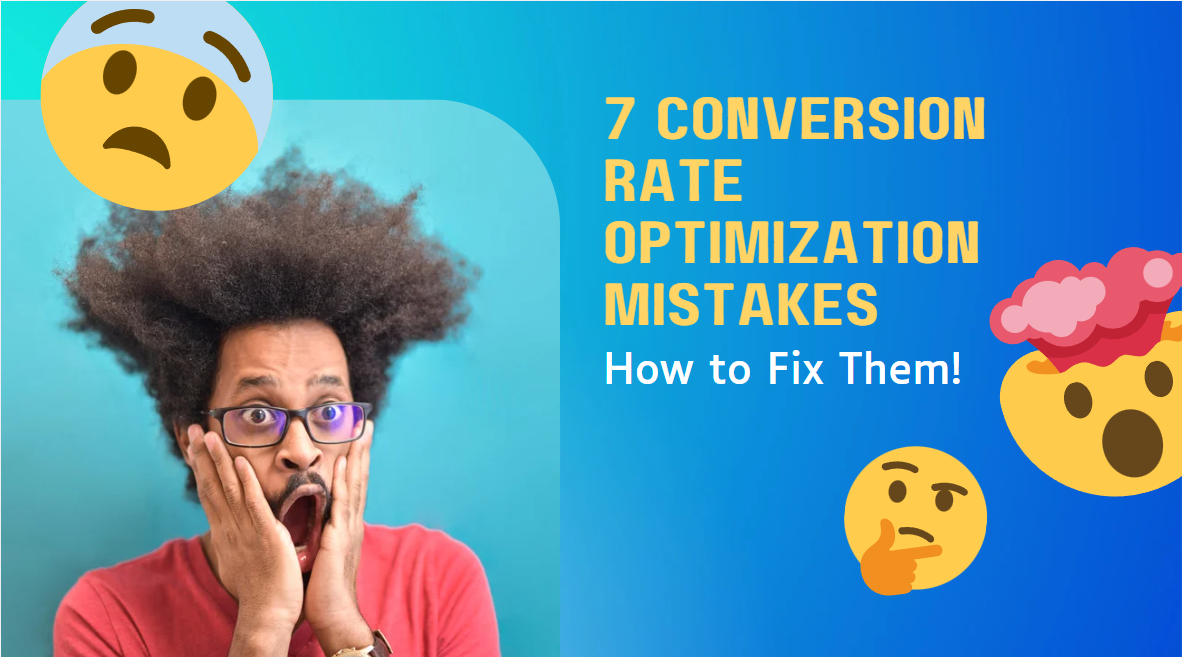Why Conversion Rate Optimization (CRO) Matters
The Impact of CRO on Business Growth
Conversion Rate Optimization (CRO) is a crucial element for any business looking to turn website visitors into paying customers. By focusing on maximizing conversions, CRO directly contributes to increased sales, customer retention, and overall profitability. The key to successful CRO lies in understanding the common pitfalls that can hinder your progress.
Common Pitfalls to Avoid
Many beginners dive into CRO with enthusiasm but often make avoidable mistakes that undermine their efforts. Understanding these mistakes and how to fix them is essential to optimizing your strategy and seeing tangible results.
Mistake #1: Focusing Only on Traffic Instead of Conversions
Why More Traffic Doesn’t Always Mean More Conversions
Driving more traffic to your website is not always the solution to boosting sales. Many beginners make the mistake of assuming that higher traffic automatically leads to more conversions, but this isn’t always the case. If your website isn’t optimized for conversions, even a surge in visitors won’t translate to increased sales.
How to Shift Focus to Conversion Metrics
To fix this, shift your focus from purely increasing traffic to enhancing the user experience and guiding visitors towards specific conversion goals. Analyze metrics like bounce rate, time on page, and conversion rate to understand visitor behavior and make necessary adjustments.
Mistake #2: Neglecting Mobile Optimization
The Rise of Mobile Users in Online Conversions
With more than half of all web traffic coming from mobile devices, neglecting mobile optimization is a critical error. A website that isn’t mobile-friendly will result in frustrated users who are likely to abandon the site before making a purchase.
Strategies for Mobile-Friendly Design
Ensure your site is responsive, meaning it adjusts seamlessly to different screen sizes. Prioritize fast load times, easy navigation, and large, clickable buttons that work well on smaller screens to enhance the mobile user experience.
Mistake #3: Ignoring the Importance of A/B Testing
The Role of A/B Testing in CRO
A/B testing allows you to compare different versions of your web pages to see which one performs better. Beginners often skip this crucial step, relying on gut feelings rather than data-driven insights to make decisions.
How to Implement Effective A/B Tests
To correct this mistake, start by testing one element at a time, such as headlines, CTAs, or images. Use reliable A/B testing tools like Optimizely or Google Optimize to gather data and refine your pages based on what works best for your audience.
Mistake #4: Poor Call-to-Action (CTA) Design
Common CTA Mistakes Beginners Make
CTAs are the driving force behind conversions, but many beginners overlook their importance. Common mistakes include vague wording, poor design, and placing the CTA in areas where they are easily missed.
How to Craft Compelling CTAs That Convert
Create CTAs that are visually distinct, with clear and concise language that compels the user to act. Use action-oriented phrases like “Get Started,” “Buy Now,” or “Sign Up Today,” and make sure they are strategically placed for maximum visibility.
Mistake #5: Overcomplicating the User Experience (UX)
Simplifying the Navigation for Better Conversions
A cluttered or confusing website can lead to high bounce rates. Beginners often make the mistake of adding too much information or too many options, which overwhelms users and reduces conversions.
The Power of Clear and Intuitive Design
Simplify your site’s layout by reducing distractions and streamlining navigation. Ensure that each step in the conversion process is intuitive, leading visitors smoothly from entry to the final action with minimal friction.
Mistake #6: Not Using Customer Feedback to Guide CRO
How to Collect Valuable Customer Insights
Ignoring customer feedback is a missed opportunity to understand what drives or deters users from converting. Direct feedback from customers provides valuable insights into what changes are needed to improve user experience and conversion rates.
Leveraging Feedback to Improve Conversions
Use tools like surveys, reviews, and feedback forms to gather honest opinions from your users. Analyze this feedback to make targeted improvements that address the specific needs and preferences of your audience.
Mistake #7: Setting Unrealistic Expectations
The Timeframe for Seeing CRO Results
Expecting immediate results from your CRO efforts is a common beginner’s mistake. CRO is a long-term strategy that requires patience, continuous testing, and adjustments based on data.
How to Set Achievable CRO Goals
Set realistic, data-driven goals for your CRO efforts. Understand that small, incremental improvements are more sustainable than expecting drastic changes overnight. Regularly review your progress and refine your strategies for better results.
Tools to Help You Avoid Common CRO Mistakes
Best Analytics Tools for Tracking CRO Performance
Tools like Google Analytics, Hotjar, and Crazy Egg are essential for tracking user behavior and conversion performance. They provide insights into how visitors interact with your website, highlighting areas for improvement.
Platforms for User Testing and Feedback
User testing platforms such as UsabilityHub and Qualaroo help you gather feedback directly from your target audience. This data is invaluable in making informed decisions to enhance the user experience and boost conversion rates.
Frequently Asked Questions (FAQs)
- Why is CRO important for my business? CRO helps you maximize the value of your existing traffic by turning more visitors into paying customers, leading to increased revenue.
- What is the most common CRO mistake? The most common mistake is focusing solely on traffic generation rather than optimizing for conversions.
- How can I start A/B testing on my website? Begin with small tests on specific elements like CTAs or headlines using tools like Google Optimize or Optimizely.
- Do I need technical knowledge for CRO? While technical skills can help, many CRO tools are user-friendly and do not require extensive technical knowledge.
- How long does CRO take to show results? Depending on your website’s traffic and the changes implemented, you can start seeing results within a few weeks to a few months.
- What tools are best for beginners in CRO? Tools like Google Analytics, Hotjar, and Crazy Egg are great for beginners to start tracking user behavior and making data-driven improvements.
Conclusion
Avoiding these common CRO mistakes can drastically improve your website’s conversion rates and overall business performance. By focusing on user experience, testing strategies, and listening to customer feedback, you can create a more effective path to turning visitors into loyal customers.




